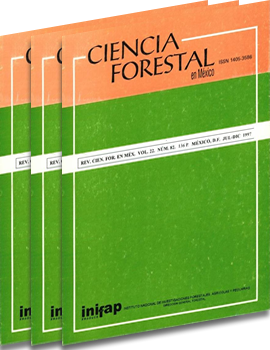PLANTACIÓN DE Pinus pseudostrobus Lindl. A RAÍZ DESNUDA Y EN ENVASE CON DOS SISTEMAS DE PREPARACIÓN DE TERRENO
Keywords:
Pinus pseudostrobus, site preparation, bare-root, forest plantations, Michoacan, MexicoAbstract
One alternative to support forest repopulation projects is bare root seedlings utilization because nursery propagation, seedling transportation and establishment costs are less than container system. In Mexico, site preparation is not a common practice, this had lead to poor survival and slow early growth; to obtain information about this concem, a study was initiated in July 1989, the locality was San Juan Nuevo Parangaricutiro, Michoacan forest lands, the goal was to observe seedling (bare-root and container) response to field conditions as modified by two competition control treatments. Pinus pseudostrobus Lindl. experimental plantation establishment was an attempt to improve planting operation for both bare-root and container seedlings. Establishment details five years survival and seedlings diameter and height development are: chaponeocontainer 95%, 5.1 cm and 3.84 m; chaponeo-bare-root 85%, 4.9 cm and 3.85 m; container-fallow: 96%, 6.8 cm and 4.71 m; bare-root-fallow 83%, 6.9 cm and 4.78 m. Establishment costs per hectare in 1996 were: land fallowed and container was $4,284.00; land fallowed and bare-root seedlings was $2,367.00; chaponeo and container$ 4,194.00 and chaponeo-bare-root was $2,277.00. Conclusions indicate that fallow influence diameter and heigh growth in 36% and 23.5% respectively versus chaponeo both container and bare-root seedlings, but there were not effects on survival indicator.
Downloads
Downloads
Published
How to Cite
Issue
Section
License
The authors who publish in Revista Mexicana de Ciencias Forestales accept the following conditions:
In accordance with copyright laws, Revista Mexicana de Ciencias Forestales recognizes and respects the authors’ moral right and ownership of property rights which will be transferred to the journal for dissemination in open access.
All the texts published by Revista Mexicana de Ciencias Forestales –with no exception– are distributed under a Creative Commons License Attribution-NonCommercial 4.0 International (CC BY-NC 4.0), which allows third parties to use the publication as long as the work’s authorship and its first publication in this journal are mentioned
The author(s) can enter into independent and additional contractual agreements for the nonexclusive distribution of the version of the article published in Revista Mexicana de Ciencias Forestales (for example, include it into an institutional repository or publish it in a book) as long as it is clearly and explicitly indicated that the work was published for the first time in Revista Mexicana de Ciencias Forestales.
For all the above, the authors shall send the form of Letter-transfer of Property Rights for the first publication duly filled in and signed by the author(s). This form must be sent as a PDF file to: ciencia.forestal2@inifap.gob.mx
This work is licensed under a Creative Commons Attribution-Noncommercial 4.0 International license.


